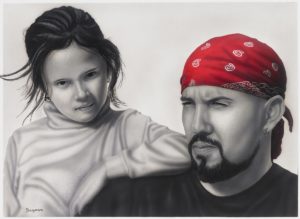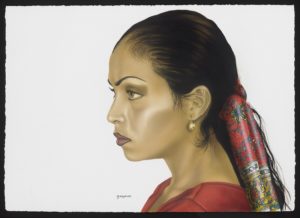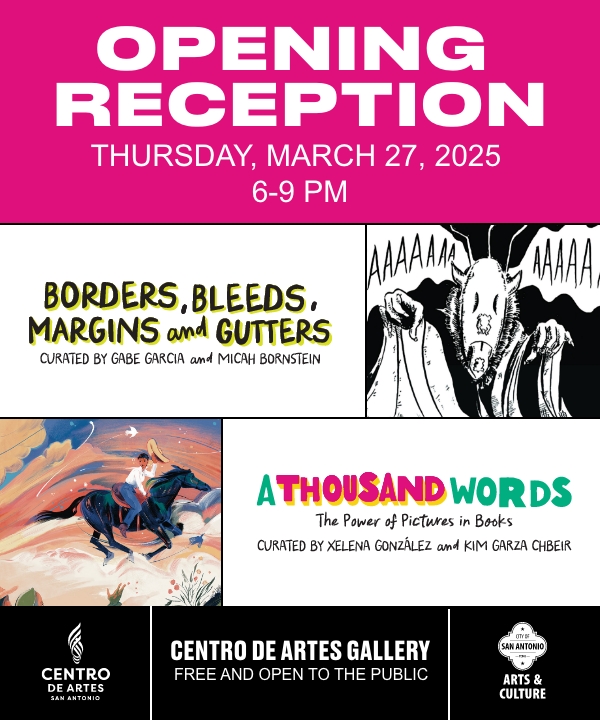By Phyllis Price
Gaspar Enriquez is the quintessential Chicano Texas artist and a fine example of what focus, commitment, and puro corazon can do to conquer early disadvantages of language and economics. His art – powerful, acrylic, air-brushed portraits of people who interest him, from former students to celebrities –asks us to perceive our fellows with clarity, without bigotry. His life we can take heart from, no matter how varied our backgrounds or ages. He’s a quiet, observant man who “doesn’t toot his own horn”.
 Born (in 1942) and raised in El Paso’s Segundo Barrio, Gaspar credits some of his courage in pursuing his art to encouragement from his mother and two sisters, his fifth-grade teacher at Beall Elementary, and his now-deceased wife, Anne Garcia-Enriquez. He left home for California at 18 to earn money as a machinist, helping support his family and simultaneously taking classes at East L.A. Junior College. Returning to El Paso in the late ‘60s, still working fulltime, he earned a BA in Art from UT-El Paso in 1970, an MA in Metals from New Mexico State University in 1985. Gaspar chose to teach in order to remain independently true to his vision. Along the way, he inspired art students at El Paso’s Bowie High School for 34 years, until his retirement sixteen years ago. (Many former students are now artists, art teachers, and/or art administrators. One “filled his shoes” at Bowie.) He’s inspired young nationally-known artists such as Vincent Valdez and Alex Rubio.
Born (in 1942) and raised in El Paso’s Segundo Barrio, Gaspar credits some of his courage in pursuing his art to encouragement from his mother and two sisters, his fifth-grade teacher at Beall Elementary, and his now-deceased wife, Anne Garcia-Enriquez. He left home for California at 18 to earn money as a machinist, helping support his family and simultaneously taking classes at East L.A. Junior College. Returning to El Paso in the late ‘60s, still working fulltime, he earned a BA in Art from UT-El Paso in 1970, an MA in Metals from New Mexico State University in 1985. Gaspar chose to teach in order to remain independently true to his vision. Along the way, he inspired art students at El Paso’s Bowie High School for 34 years, until his retirement sixteen years ago. (Many former students are now artists, art teachers, and/or art administrators. One “filled his shoes” at Bowie.) He’s inspired young nationally-known artists such as Vincent Valdez and Alex Rubio.
 Gaspar’s dramatic portraits range in size from 24 feet high (the cholos commissioned for the San Antonio Convention Center) to page illustrations for Rudolfo Anaya’s Elegy on the Death of Cesar Chavez. No matter their size, his paintings reveal his subjects’ dignity, require you to “pay attention”. They arrest you; often the subjects are looking at you. The works’ intensity has earned Gaspar a national reputation. His latest solo exhibition, Una Pagina Mas, ran March – May, 2006, at the Tucson Museum of Art. His most recent group exhibition just opened at the de Young Museum in San Francisco – the nationally touring Chicano Visions, curated from actor “Cheech” Marin’s private collection. Museums purchasing Gaspar’s work include the Tucson Museum of Art, El Paso Museum of Art, Lyndon Baines Johnson Library, and the Albuquerque Museum of Art. His art was part of Chicano Art/Resistance and Affirmation, curated by the Wight Art Gallery at UCLA, which toured museums all over the US. His work has been reviewed in newspapers, art magazines and catalogues.
Gaspar’s dramatic portraits range in size from 24 feet high (the cholos commissioned for the San Antonio Convention Center) to page illustrations for Rudolfo Anaya’s Elegy on the Death of Cesar Chavez. No matter their size, his paintings reveal his subjects’ dignity, require you to “pay attention”. They arrest you; often the subjects are looking at you. The works’ intensity has earned Gaspar a national reputation. His latest solo exhibition, Una Pagina Mas, ran March – May, 2006, at the Tucson Museum of Art. His most recent group exhibition just opened at the de Young Museum in San Francisco – the nationally touring Chicano Visions, curated from actor “Cheech” Marin’s private collection. Museums purchasing Gaspar’s work include the Tucson Museum of Art, El Paso Museum of Art, Lyndon Baines Johnson Library, and the Albuquerque Museum of Art. His art was part of Chicano Art/Resistance and Affirmation, curated by the Wight Art Gallery at UCLA, which toured museums all over the US. His work has been reviewed in newspapers, art magazines and catalogues.
Retired from teaching, he’s creating his art – and another visionary project: restoring an ancient adobe building to studio spaces in the 400-year-old presidio of San Elizario in El Paso’s Mission Valley.
IN THIS BODY OF WORK THE IMAGES ARE METAPHORS FOR PAGES IN A VISUAL NOVEL PORTRAYING A SUBCULTURE THAT HAS ENDURED IN THE MEXICAN AMERICAN COMMUNITY SINCE THE SECOND WORLD WAR. ONE IS BORN A MEXICAN AMERICAN, BUT ONE CHOOSES TO BE A CHICANO. POLITICALLY CHARGED, THE CHICANO LIFE STYLE HAS BEEN PASSED FROM ONE GENERATION TO ANOTHER. IT HAS SURVIVED WARS, PRISONS, AND STRIFE.
THE IMAGES REFLECT A LIFE STYLE AND AN ATTITUDE DOMINANT IN THE BARRIOS. THIS STYLE IS IDENTIFIED BY THE STYLE OF DRESS, MANNERISM, AND LANGUAGE. MANY CHICANOS USE A SLANG CALLED CALO TO COMMUNICATE AND, WHEN IT WAS ALLOWED, MANY DEVELOPED THEIR OWN SIGN LANGUAGE TO COMMUNICATE WITH LOVED ONES INCARCERATED IN THE COUNTY JAIL. STANDING IN THE STREETS BELOW THE JAIL, WOMEN WOULD SIGN TO THEIR BOYFRIENDS HELD IN CELLS ON THE UPPER FLOORS. THIS ACTIVITY NO LONGER TAKES PLACE SINCE THE WINDOWS OF THE JAIL HAVE BEEN COVERED.
THE WORK DEALS WITH INDIVIDUALS WHOSE LIVES HAVE BEEN A PART OF MY ENVIRONMENT. THEY ARE INDIVIDUALS WHO REMIND ME OF FRIENDS AND ACQUAINTANCES I GREW UP WITH .
THE WORK IS NOT A CRUSADE TO CHANGE LIVES NOR IS IT AN EFFORT TO PASS JUDGEMENT. IT IS UP TO THE VIEWER TO JUDGE AND INTERPRET. THESE IMAGES INVITES THE VIEWER TO COME INTO CONTACT WITH SOME OF THOSE WHO POPULATE THE CHICANO WORLD.
AS LONG AS THERE IS POVERTY EN EL BARRIO ( IN THE NEIGHBORHOOD ) THIS LIFE STYLE WILL ENDURE MY GENERATION AND GENERATIONS TO COME . AN IDENTITY IS IMPORTANT TO ALL OF US. THIS LIFE STYLE REFLECTS THE AVENUE SOME INDIVIDUALS TAKE, SEARCHING FOR AN IDENTITY AND SELF ESTEEM .










